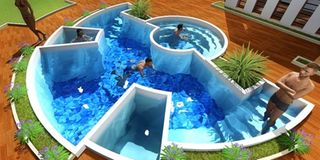Build a plunge pool to save space

The affordable price and low maintenance costs added to the fact that the pool adds value to the property are a very good reason to opt for a small size pool. Courtesy photo
What you need to know:
- Small plunge pools design ideas are the perfect option for people who have limited outdoor space.
- This type of pool will give you an authentic experience even if you have a small backyard.
Most people would love to have the pleasure of having swimming pools in their home but are limited by space and money. In addition to adding value to your home, a pool offers fitness, relaxation and is an excellent venue for private parties.
Simon Peter Kazibwe, an a from Royal architects, designed this pool which is larger than a spa but smaller than the usual swimming pool to fit on small spaces. The customised pool can easily fit on a 7mx7m piece of land and is 1.5m deep.
Before you start planning for your luxurious water treat, you need to meet with a swimming pool constructor who will help you evaluate your outdoor space and your aesthetic wishes to determine an appropriate design for your yard. The pool will be installed once the plan is developed and approved.
This kind of pool is referred to by pool manufacturers as a plunge pool. According to online portal homeimprovementpages.com the term “plunge pool” was adopted by the pool industry to describe a pool that is larger than a spa but smaller than a normal swimming pool. Manufacturers began designing these pools in response to customer demands for pools that offered the advantages of a swimming pool in a restricted area.
Plunge pools follow no particular rules to shape or size. “Because of their fluidity in shape and size, plunge pools can be constructed using a variety of materials such as fibreglass or concrete and can be designed to fit the shape of your plot,” Kazibwe explains.
For this particular pool, Kazibwe incorporated individual compartments with both hot and cold water streams. Using concrete, cement and ordinary tiles, the architect says the pool costs Shs40m to construct.
Concrete pools have the advantage that they can be built into virtually any shape or size.
Different from hot tub
There is some confusion between a plunge pool and a hot tub which is probably due to the small size. However, the major difference between the two is water temperature.
Hot tubs, as we all know, are filled with hot water while plunge pools are filled with cold water. Sometimes both are designed and constructed together if the available space allows to have them both and if the homeowner wants to take advantage of both hot and cold water.
Risks
There are risks associated with these pools. Not only are they costly and time-consuming to install they are heavily affected by the weather and soil structure too.
These pools are also more expensive to heat. These costs are spread between the various necessary processes involved in pool construction such as excavation, landscaping and electrical wiring expenses.
Tips on maintenance
Once you have finished constructing your pool, you will need to do regular cleaning, water testing, renovations and equipment replacement or repairs.
Safety tips
•Supervise children. A responsible adult should be watching children without distractions such as reading or chatting at all times.
•Make sure at least one responsible adult knows CPR. Having CPR skills saves lives. In the time it takes for the paramedics to arrive, a person could die.
•Keep the pool area clear of toys. If a toy is not being used, it should be far from the pool deck.
•Never dive into shallow water. Less than six feet is too shallow.
•Stay out of water during thunderstorms. You should be out of the water for at least 30 minutes after hearing thunder or seeing lightning.
•Avoid consuming too much alcohol. Swimming drunk can be as dangerous as driving drunk.
•Know your limits. It is important to know your abilities and limits. Leave the pool before a situation can become dangerous.




